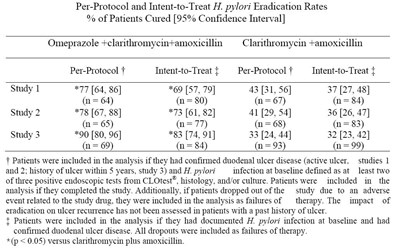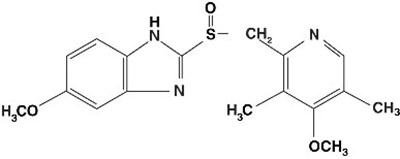Product Images Omeprazole
View Photos of Packaging, Labels & Appearance
Product Label Images
The following 11 images provide visual information about the product associated with Omeprazole NDC 45865-342 by Medsource Pharmaceuticals, such as packaging, labeling, and the appearance of the drug itself. This resource could be helpful for medical professionals, pharmacists, and patients seeking to verify medication information and ensure they have the correct product.
Pic 10 - omeprazole delayed release 20mg 10

This is a report on the effectiveness of three drugs: Omeprazole at 20 mg once daily, Omeprazole at 10 mg once daily, and Ranitidine at 150 mg twice daily, on achieving endoscopic remission after 12 months. The report includes the number of participants (131 for Omeprazole 20mg, 133 for Omeprazole 10mg, and 128 for Ranitidine) and the percentages of them who achieved remission (77%, 158%, and 46% respectively). The report also includes p-values for comparing the different drug treatments.*
15 Tablet Label - omeprazole delayed release 20mg 11

The text appears to be a medication label for "MEPRAZOLE DELAYED RELEASE CAPSULES 20 MG". It includes the National Drug Code (NDC) and directions for use, which suggest taking the capsule three times a day. An expiration date is also provided.*
Pic 2 - omeprazole delayed release 20mg 2

This is a table showing the per-protocol and intent-to-treat H. pylori eradication rates for patients who were included in the analysis if they had confirmed duodenal ulcer disease and H. pylori infection at the baseline. The patients were treated either with Omeprazole+clarithromycin+amoxicillin or Clarithromycin+amoxicillin in three different studies. The table shows the percentage of patients cured along with the 95% confidence interval. In addition, patients who dropped out of the study due to adverse drug events were included in the analysis as therapy failures. The impact of eradication on ulcer recurrence in patients with a past history of ulcer has not been assessed in the study.*
Pic 3 - omeprazole delayed release 20mg 3

This text provides data on the eradication rates of H. pylori using different treatments in various studies. The table shows the percentage of patients cured, with 95% confidence intervals, over a period of 4 to 6 weeks using omeprazole+clarithromycin treatment and monotherapy of either omeprazole or clarithromycin. The data shows that omeprazole+clarithromycin treatment has a statistically significantly higher cure rate compared to clarithromycin monotherapy, and omeprazole monotherapy in some studies. The text also mentions non-U.S. studies but does not provide complete data for them.*
Pic 4 - omeprazole delayed release 20mg 4

This is a chart/table showing the rates of recurrence of duodenal ulcer in patients based on their H. pylori eradication status. The results are displayed for different studies conducted in the US and non-US countries, along with the number of patients studied. The assessment of H. pylori eradication status was done at the same time point as the ulcer recurrence. The treatment arms used in the studies were omeprazole + clarithromycin and omeprazole with clarithromycin.*
Pic 5 - omeprazole delayed release 20mg 5

This is a report on a treatment for Gastric Ulcer that compares 20 mg once-daily Omeprazole, 40 mg once-daily Omeprazole, and Placebo. The percentage of patients healed after 4 weeks and 8 weeks is recorded for both Omeprazole doses and Placebo. The report concludes that both Omeprazole doses are highly effective compared to Placebo, and that the performance of the 40 mg dose is better than that of the 20 mg dose.*
Pic 6 - omeprazole delayed release 20mg 6

This is a table presenting the results of a clinical trial comparing the effectiveness of different treatments for gastric ulcer. The treatments evaluated were omeprazole 20 mg once daily, omeprazole 40 mg once daily, and ranitidine 150 mg twice daily. The table shows the percentage of patients healed after four weeks and eight weeks of treatment for each group. The results indicate that omeprazole 40 mg once daily was significantly more effective than the other two treatments.*
Pic 7 - omeprazole delayed release 20mg 7

The text displays a table comparing the successful symptomatic outcome of Omeprazole 20 mg versus Omeprazole 10 mg and a Placebo. The results are based on the resolution of heartburn in patients with confirmed GERD. Omeprazole 20 mg proved significantly more effective than the other two options.*
Pic 8 - omeprazole delayed release 20mg 8

This is a study comparing the effects of two different doses of Omeprazole (20mg and 40mg) versus a placebo. The study was conducted over 8 weeks with a total of 213 participants divided into 3 groups (83 in the 20mg group, 87 in the 40mg group, and 43 in the placebo group). The efficacy of the treatments was evaluated based on percentages obtained at weeks 4 and 8, with a statistically significant difference observed between the two Omeprazole groups and the placebo group (p<0.01). However, due to the limited and incomplete nature of the text, it is not possible to determine the exact nature or specifics of the effects observed.*
Pic 9 - omeprazole delayed release 20mg 9

This text describes a study comparing the efficacy of different dosages of Omeprazole and placebo in treating a medical condition, possibly related to endoscopy. The study found that taking Omeprazole 20mg once daily produced better results in achieving endoscopic remission after 6 months compared to taking it for 3 consecutive days per week, or taking a placebo. The difference in effectiveness was statistically significant (p < 0.01).*
* The product label images have been analyzed using a combination of traditional computing and machine learning techniques. It should be noted that the descriptions provided may not be entirely accurate as they are experimental in nature. Use the information in this page at your own discretion and risk.
